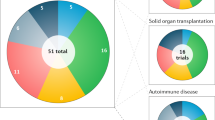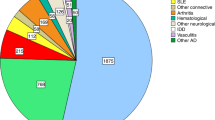Abstract
Agents interfering with T cell function are therapeutic mainstays for various autoimmune diseases and for transplant approaches to organ failure. The understanding of T cell biology has blossomed since the development of most agents now in use. Here we discuss T cell–specific agents now in use, others recently added to the therapeutic armamentarium and promising agents being investigated in clinical and preclinical studies. In addition, we reflect on the risks and benefits involved in the testing of such agents clinically, with examples of agents that have successfully been used in the clinic and agents that failed to reach therapeutic use.
This is a preview of subscription content, access via your institution
Access options
Subscribe to this journal
Receive 12 print issues and online access
$209.00 per year
only $17.42 per issue
Buy this article
- Purchase on Springer Link
- Instant access to full article PDF
Prices may be subject to local taxes which are calculated during checkout

Similar content being viewed by others
References
Abraham, R.T. & Weiss, A. Jurkat T cells and development of the T-cell receptor signalling paradigm. Nat. Rev. Immunol. 4, 301–308 (2004).
Starzl, T.E. et al. The clinical use of antilymphocyte globulin in renal homotransplantation. Transplantation 5, 1100–1005. (1967).
Cosimi, A.B. et al. Use of monoclonal antibodies to T-cell subsets for immunologic monitoring and treatment in recipients of renal allografts. N. Engl. J. Med. 305, 308–314 (1981).
Charpentier, B. et al. Evidence that antihuman tumor necrosis factor monoclonal antibody prevents OKT3-induced acute syndrome. Transplantation 54, 997–1002 (1992).
Weinshenker, B.G., Bass, B., Karlik, S., Ebers, G.C. & Rice, G.P. An open trial of OKT3 in patients with multiple sclerosis. Neurology 41, 1047–1052 (1991).
Xu, D. et al. In vitro characterization of five humanized OKT3 effector function variant antibodies. Cell. Immunol. 200, 16–26 (2000).
Utset, T.O. et al. Modified anti-CD3 therapy in psoriatic arthritis: a phase I/II clinical trial. J. Rheumatol. 29, 1907–1913 (2002).
Herold, K.C. et al. Anti-CD3 monoclonal antibody in new-onset type 1 diabetes mellitus. N. Engl. J. Med. 346, 1692–1698 (2002).
Coles, A.J. et al. Pulsed monoclonal antibody treatment and autoimmune thyroid disease in multiple sclerosis. Lancet 354, 1691–1695 (1999).
Friend, P.J. et al. Campath-1M–prophylactic use after kidney transplantation. A randomized controlled clinical trial. Transplantation 48, 248–253 (1989).
Hale, G. et al. Removal of T cells from bone marrow for transplantation: a monoclonal antilymphocyte antibody that fixes human complement. Blood 62, 873–882 (1983).
Hale, G. & Waldmann, H. CAMPATH-1 monoclonal antibodies in bone marrow transplantation. J. Hematother. 3, 15–31 (1994).
Isaacs, J.D. et al. CAMPATH-1H in rheumatoid arthritis–an intravenous dose-ranging study. Br. J. Rheumatol. 35, 231–240 (1996).
Wendling, D. et al. A randomized, double blind, placebo controlled multicenter trial of murine anti-CD4 monoclonal antibody therapy in rheumatoid arthritis. J. Rheumatol. 25, 1457–1461 (1998).
Choy, E.H., Chikanza, I.C., Kingsley, G.H., Corrigall, V. & Panayi, G.S. Treatment of rheumatoid arthritis with single dose or weekly pulses of chimaeric anti-CD4 monoclonal antibody. Scand. J. Immunol. 36, 291–298 (1992).
Critchfield, J.M. & Lenardo, M.J. Antigen-induced programmed T cell death as a new approach to immune therapy. Clin. Immunol. Immunopathol. 75, 13–19 (1995).
Critchfield, J.M. et al. T cell deletion in high antigen dose therapy of autoimmune encephalomyelitis. Science 263, 1139–1143 (1994).
Xu, Y. et al. Fc gamma Rs modulate cytotoxicity of anti-Fas antibodies: implications for agonistic antibody-based therapeutics. J. Immunol. 171, 562–568 (2003).
Tang, Q. et al. Visualizing regulatory T cell control of autoimmune responses in nonobese diabetic mice. Nat. Immunol. 7, 83–92 (2006).
Bluestone, J.A. & Tang, Q. How do CD4+CD25+ regulatory T cells control autoimmunity? Curr. Opin. Immunol. 17, 638–642 (2005).
Calne, R. Cyclosporine as a milestone in immunosuppression. Transplant. Proc. 36, 13S–15S (2004).
Crabtree, G.R. Calcium, calcineurin, and the control of transcription. J. Biol. Chem. 276, 2313–2316 (2001).
Rusnak, F. & Mertz, P. Calcineurin: form and function. Physiol. Rev. 80, 1483–1521 (2000).
Ojo, A.O. et al. Chronic renal failure after transplantation of a nonrenal organ. N. Engl. J. Med. 349, 931–940 (2003).
Chambers, C.A., Kuhns, M.S. & Allison, J.P. Cytotoxic T lymphocyte antigen-4 (CTLA-4) regulates primary and secondary peptide-specific CD4+ T cell responses. Proc. Natl. Acad. Sci. USA 96, 8603–8608 (1999).
Bluestone, J.A., St Clair, E.W. & Turka, L.A. CTLA4Ig: bridging the basic immunology with clinical application. Immunity 24, 233–238 (2006).
Genovese, M.C. et al. Abatacept for rheumatoid arthritis refractory to tumor necrosis factor alpha inhibition. N. Engl. J. Med. 353, 1114–1123 (2005).
Vincenti, F. et al. Costimulation blockade with belatacept in renal transplantation. N. Engl. J. Med. 353, 770–781 (2005).
Beck, K.E. et al. Enterocolitis in patients with cancer after antibody blockade of cytotoxic T-lymphocyte-associated antigen 4. J. Clin. Oncol. 24, 2283–2289 (2006).
Phan, G.Q. et al. Cancer regression and autoimmunity induced by cytotoxic T lymphocyte-associated antigen 4 blockade in patients with metastatic melanoma. Proc. Natl. Acad. Sci. USA 100, 8372–8377 (2003).
Tang, Q. et al. Cutting edge: CD28 controls peripheral homeostasis of CD4+CD25+ regulatory T cells. J. Immunol. 171, 3348–3352 (2003).
Vitetta, E.S. & Ghetie, V.F. Immunology. Considering therapeutic antibodies. Science 313, 308–309 (2006).
Daikh, D.I., Finck, B.K., Linsley, P.S., Hollenbaugh, D. & Wofsy, D. Long-term inhibition of murine lupus by brief simultaneous blockade of the B7/CD28 and CD40/gp39 costimulation pathways. J. Immunol. 159, 3104–3108 (1997).
Kirk, A.D. et al. Treatment with humanized monoclonal antibody against CD154 prevents acute renal allograft rejection in nonhuman primates. Nat. Med. 5, 686–693 (1999).
Kawai, T., Andrews, D., Colvin, R.B., Sachs, D.H. & Cosimi, A.B. Thromboembolic complications after treatment with monoclonal antibody against CD40 ligand. Nat. Med. 6, 114 (2000).
Feldmann, M. Development of anti-TNF therapy for rheumatoid arthritis. Nat. Rev. Immunol. 2, 364–371 (2002).
Vincenti, F. et al. Interleukin-2-receptor blockade with daclizumab to prevent acute rejection in renal transplantation. Daclizumab Triple Therapy Study Group. N. Engl. J. Med. 338, 161–165 (1998).
Nashan, B. et al. Randomised trial of basiliximab versus placebo for control of acute cellular rejection in renal allograft recipients. CHIB 201 International Study Group. Lancet 350, 1193–1198 (1997).
Bielekova, B. et al. Humanized anti-CD25 (daclizumab) inhibits disease activity in multiple sclerosis patients failing to respond to interferon β. Proc. Natl. Acad. Sci. USA 101, 8705–8708 (2004).
Yakupoglu, Y.K. & Kahan, B.D. Sirolimus: a current perspective. Exp. Clin. Transplant. 1, 8–18 (2003).
Waldmann, T.A. IL-15 in the life and death of lymphocytes: immunotherapeutic implications. Trends Mol. Med. 9, 517–521 (2003).
Baslund, B. et al. Targeting interleukin-15 in patients with rheumatoid arthritis: a proof-of-concept study. Arthritis Rheum. 52, 2686–2692 (2005).
Hommes, D.W. et al. Fontolizumab, a humanised anti-interferon-γ antibody, demonstrates safety and potential clinical activity in patients with moderate-to-severe Crohn's disease. Gut 55, 1131–1137 (2006).
Hunter, C.A. New IL-12-family members: IL-23 and IL-27, cytokines with divergent functions. Nat. Rev. Immunol. 5, 521–531 (2005).
Mannon, P.J. et al. Anti-interleukin-12 antibody for active Crohn's disease. N. Engl. J. Med. 351, 2069–2079 (2004).
Casanova, J.L. & Abel, L. Genetic dissection of immunity to mycobacteria: the human model. Annu. Rev. Immunol. 20, 581–620 (2002).
Gadina, M. et al. Signaling by type I and II cytokine receptors: ten years after. Curr. Opin. Immunol. 13, 363–373 (2001).
Macchi, P. et al. Mutations of Jak-3 gene in patients with autosomal severe combined immune deficiency (SCID). Nature 377, 65–68 (1995).
Changelian, P.S. et al. Prevention of organ allograft rejection by a specific Janus kinase 3 inhibitor. Science 302, 875–878 (2003).
Shaw, M.H. et al. A natural mutation in the Tyk2 pseudokinase domain underlies altered susceptibility of B10.Q/J mice to infection and autoimmunity. Proc. Natl. Acad. Sci. USA 100, 11594–11599 (2003).
Minegishi, Y. et al. Human tyrosine kinase 2 deficiency reveals its requisite roles in multiple cytokine signals involved in innate and acquired immunity. Immunity 25, 745–755 (2006).
O'Shea, J.J., Gadina, M. & Schreiber, R.D. Cytokine signaling in 2002: new surprises in the Jak/Stat pathway. Cell 109, S121–S131 (2002).
Wormald, S. & Hilton, D.J. Inhibitors of cytokine signal transduction. J. Biol. Chem. 279, 821–824 (2004).
Croft, M. Co-stimulatory members of the TNFR family: keys to effective T-cell immunity? Nat. Rev. Immunol. 3, 609–620 (2003).
Nocentini, G. & Riccardi, C. GITR: a multifaceted regulator of immunity belonging to the tumor necrosis factor receptor superfamily. Eur. J. Immunol. 35, 1016–1022 (2005).
Matloubian, M. et al. Lymphocyte egress from thymus and peripheral lymphoid organs is dependent on S1P receptor 1. Nature 427, 355–360 (2004).
Mandala, S. et al. Alteration of lymphocyte trafficking by sphingosine-1-phosphate receptor agonists. Science 296, 346–349 (2002).
Brinkmann, V., Pinschewer, D.D., Feng, L. & Chen, S. FTY720: altered lymphocyte traffic results in allograft protection. Transplantation 72, 764–769 (2001).
Tedesco-Silva, H. et al. FTY720, a novel immunomodulator: efficacy and safety results from the first phase 2A study in de novo renal transplantation. Transplantation 79, 1553–1560 (2005).
Kappos, L. et al. Oral fingolimod (FTY720) for relapsing multiple sclerosis. N. Engl. J. Med. 355, 1124–1140 (2006).
Berlin, C. et al. α4 integrins mediate lymphocyte attachment and rolling under physiologic flow. Cell 80, 413–422 (1995).
Polman, C.H. et al. A randomized, placebo-controlled trial of natalizumab for relapsing multiple sclerosis. N. Engl. J. Med. 354, 899–910 (2006).
Kleinschmidt-DeMasters, B.K. & Tyler, K.L. Progressive multifocal leukoencephalopathy complicating treatment with natalizumab and interferon β-1a for multiple sclerosis. N. Engl. J. Med. 353, 369–374 (2005).
Acknowledgements
Supported by the Intramural Research Program of the National Institutes of Health, National Institute of Diabetes and Digestive and Kidney Diseases, and National Institute of Arthritis, Musculoskeletal and Skin Diseases.
Author information
Authors and Affiliations
Corresponding author
Ethics declarations
Competing interests
The National Institutes of Health and J.J.O. hold a patent relating to Jak3 and immunosuppressive drugs.
Rights and permissions
About this article
Cite this article
Liu, E., Siegel, R., Harlan, D. et al. T cell–directed therapies: lessons learned and future prospects. Nat Immunol 8, 25–30 (2007). https://doi.org/10.1038/ni1429
Issue Date:
DOI: https://doi.org/10.1038/ni1429
This article is cited by
-
Biologika als Immunsuppressiva bei Nierentransplantation
Der Nephrologe (2014)
-
New perspectives on the biology of acute GVHD
Bone Marrow Transplantation (2010)
-
The safety and side effects of monoclonal antibodies
Nature Reviews Drug Discovery (2010)
-
Pancreatic beta cell function persists in many patients with chronic type 1 diabetes, but is not dramatically improved by prolonged immunosuppression and euglycaemia from a beta cell allograft
Diabetologia (2009)



